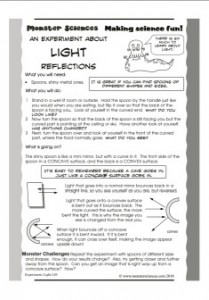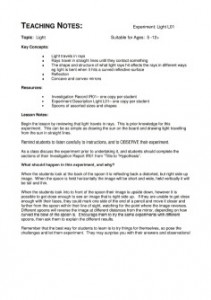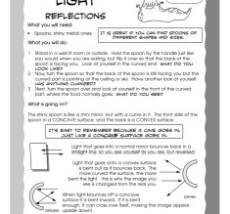Start your understanding of the wonders of light by investigating how it travels and bends.
 |
 |
Light Science Experiment: Reflections
What you will need:
Spoons, shiny metal ones.
What you will do:
1. Stand in a well lit room or outside. Hold the spoon by the handle just like you would when you are eating, but flip it over so that the back of the spoon is facing you. Look at yourself in the curved end, what do you look like?
2. Now turn the spoon so that the back of the spoon is still facing you but the curved part is pointing at the ceiling or sky. Have another look at yourself.
3 Next, turn the spoon over and look at yourself in the front of the curved part where the food normally goes. What do you see?
What is going on?
The shiny spoon is like a mini mirror, but with a curve in it. The front of the spoon is a CONCAVE surface, and the back is a CONVEX surface.
Light that goes into a normal mirror bounces back in a straight line, so you see yourself as you are, but reversed. Light that goes onto a convex surface is bent out as it bounces back, the more curved the surface, the more the light is bent. This is why the image you see is changed from the real you.
When light bounces off a concave surface it is bent inward. If it is bent enough it can cross over itself, making the image appear upside down!
Monster Challenges
Repeat the experiment with spoons of different sizes and shapes, away from the spoon. How do your results change? Also, try getting closer and further. Can you get an image that is right way up from a concave surface?
Teaching Notes: Monster Sciences Experiment: Light L01
Topic:
Light
Key Concepts:
- Light travels in rays
- Rays travel in straight lines until they contact something
- The shape and structure of what light rays hit affects the rays in different ways eg light is bent when it hits a curved reflective surface
- Reflection
- Concave and convex mirrors
Resources:
- Investigation Record IR01– one copy per student
- Experiment Description Light L01– one copy per student
- Spoons of assorted sizes and shapes
Lesson Notes:
Begin the lesson by reviewing that light travels in rays. This is prior knowledge for this experiment. This can be as simple as drawing the sun on the board and drawing light travelling from the sun in straight lines.
Remind students to listen carefully to instructions, and to OBSERVE their experiment.
As a class discuss the experiment prior to undertaking it, and students should complete the sections of their Investigation Report IR01 from ”Title to “Hypothesis”.
What should happen in this experiment, and why?
When the students look at the back of the spoon it is reflecting back a distorted, but right side up image. When the spoon is held horizontally the image will be short and wide, held vertically it will be tall and thin.
When the students look into to front of the spoon their image is upside down, however it is possible to get close enough to see an image that is right side up. If they are unable to get close enough with their faces, they could mark one side of the end of a pencil and move it closer and further from the spoon within their line of sight, watching for the point where the image reverses. Different spoons will reverse the image at different distances from the mirror, depending on how curved the bowl of the spoon is. Encourage them to try the same experiments with different spoons, then ask them to explain the different results.
Remember that the best way for students to learn is to try things for themselves, so pose the challenges and let them experiment. They may surprise you with their answers and observations!
Follow up discussion questions:
- What is different between the big spoons and the little spoons? What about the deep spoons and the shallow spoons?
- What other surfaces would have the same effect on light rays?
- What sort of things could this be useful for?
- Have you seen this effect before? Where?
- What do you think might happen if the spoon wasn’t shiny?



